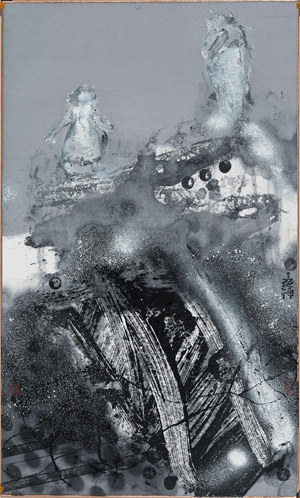|
"On one occasion, I came back to Beijing from Tianjin by train. When the train approached the station, I suddenly saw the view outside the window change drastically. Junk had started piling up along the tracks. Nature was contaminated. It was a shocking scene for me."
In response to the deteriorating environment, Shao decided to start his work with environmentalism. Though Shao adopted new skills and forms to present urban garbage on paper, he did not abandon the basic and necessary materials of traditional ink paintings, including brush pen, thin rice paper and black ink. The major difference was that Shao made the ink more abstract with thick lines, bold shadows and chaotic shapes, displaying the pains and depression of humans surrounded by increasing garbage.
 |
|
GREY FUTURE: In an ink painting from the Urban Garbage series by Shao Ge, a little girl staggers through a mess of trash, showing the harmful effect of the polluted environment on the development of children COURTESY OF SHAO GE | With the series Urban Garbage, Shao attended the Contemporary Experimental Art Show for Urban Theme in Beijing in 1999. Shao's paintings attracted considerable attention for their unique techniques and proactive environmentalist thought. As a result, most of his works were collected by the Guangdong Museum of Art. Afterward, Shao became a painter at the institute.
Along with China's urbanization and industrialization, Shao found many new problems and phenomena, providing sufficient materials for him to enrich and improve the urban-themed paintings. For example, plastic bags have been widely used in supermarkets, but consumers seldom think of the harmful impact of the thin bags on nature.
Shao hoped to remind the public of the environmental crisis with his paintings.
"Traditionally, beautiful landscapes are an important theme for Chinese paintings. But our world is rapidly changing today," Shao said. "Each time we look outside cement buildings, gray skies and piles of garbage come into our periphery. How can we concentrate on painting those beautiful natural scenes?"
"Artists have the responsibility to reflect the potential dangers of rapidly-expanding cities, and arouse people's attention to keep balance between industrial civilization and nature. For artists, painting is not leisure, but a call of inspiration and enlightenment."
Apart from environmentalism, Shao is dedicated to making his contribution to the development of Chinese paintings in postmodern times.
"Chinese artists should preserve and promote ink paintings because it is our precious heritage. But we can't limit ourselves to the existing forms," Shao said.
"Over a thousand years, Chinese painting has evolved unique aesthetic values. For example, Chinese people admire the combination of half-abstract and half-realistic rather than completely realistic. Only by using ink and thin rice paper can a painter have such an elegant impact. We cannot lose the key parts of Chinese painting."
However, some traditional principles fail to adapt to contemporary society. The themes of paintings are much enlarged. Thus, contemporary painters need to innovate to revive Chinese painting, Shao said.
"It is necessary to rectify people's misunderstanding of experimental ink paintings. Many Chinese artists have made a good try on experimental paintings. Despite the influence of Western paintings, we are rooted on traditional culture," said Shao. "All these experimental paintings constitute an innovative art form for expressing the spirit and mental world of contemporary Chinese."
Email us at: baishi@bjreview.com | 